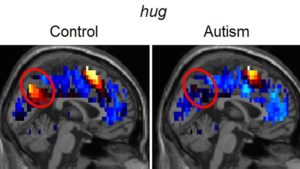
Results from Carnegie Mellon University research show the difference in brain processing when told to “think about hugs.”
DATING IS DIFFICULT, even with finely tuned social skills and a winning personality. Rejection in romantic relationships often leads people to wonder “what they did wrong” and what the heck is even going on. In the US, for the 3.5 million individuals on the autistic spectrum who have impaired communication and social interaction, dating is a daunting task. Common issues reported from autistic romantic relationships include: being unable to make conversation, respecting boundaries, and noticing nonverbal cues. With these traits come great misunderstandings, incorrect assumptions, and bad feels. In order to avoid this, it is important to understand the generalized effects of autism in the brain and know how these brain differences alter behavior and affect relationship building.
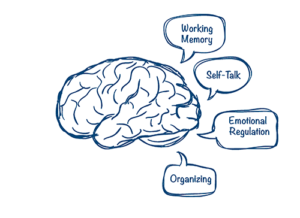 HIGHER ORDER PROCESSING: ASD individuals often struggle with challenges related to higher order processes called Executive Functioning (EF). EF helps individuals manage themselves and their resources in order to achieve a goal. It touches on the individual’s mental flexibility, inhibition, working memory, and planning ability. Theory of Mind (ToM), another higher order process, is the ability to assign mental states like beliefs, intents, desires, and emotions to oneself and others, while understanding that others also have their own varying mental states. An ASD individual lacking in typically functioning EF and ToM may struggle to abruptly switch topics, control repetitive movements, process information in loud and crowded areas, build a daily schedule, and visualize situations from other peoples’ perspectives. But where in the brain, exactly, might these higher order processes be found?
HIGHER ORDER PROCESSING: ASD individuals often struggle with challenges related to higher order processes called Executive Functioning (EF). EF helps individuals manage themselves and their resources in order to achieve a goal. It touches on the individual’s mental flexibility, inhibition, working memory, and planning ability. Theory of Mind (ToM), another higher order process, is the ability to assign mental states like beliefs, intents, desires, and emotions to oneself and others, while understanding that others also have their own varying mental states. An ASD individual lacking in typically functioning EF and ToM may struggle to abruptly switch topics, control repetitive movements, process information in loud and crowded areas, build a daily schedule, and visualize situations from other peoples’ perspectives. But where in the brain, exactly, might these higher order processes be found?
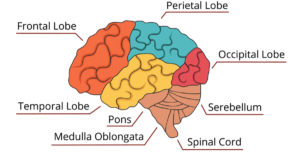 THE BRAIN: The complex brain consists of 100 billion nerves that receive and send information to its specialized areas and rest of the body through intricate wiring. EF and ToM functions are located primarily in the prefrontal regions of the frontal lobe with several connections to other cortical, subcortical, and brainstem regions. In ASD brains, abnormalities in the corpus callosum (connects the two brain hemispheres), amygdala (affects emotion and social behavior), and cerebellum (facilitates balance and coordination) have been discovered. Despite all the studies, nobody is certain about localization of function or what process contributes most to autistic behavior. This post will try to focus on ASD brain characteristics that suggest commonality among all forms of autism.
THE BRAIN: The complex brain consists of 100 billion nerves that receive and send information to its specialized areas and rest of the body through intricate wiring. EF and ToM functions are located primarily in the prefrontal regions of the frontal lobe with several connections to other cortical, subcortical, and brainstem regions. In ASD brains, abnormalities in the corpus callosum (connects the two brain hemispheres), amygdala (affects emotion and social behavior), and cerebellum (facilitates balance and coordination) have been discovered. Despite all the studies, nobody is certain about localization of function or what process contributes most to autistic behavior. This post will try to focus on ASD brain characteristics that suggest commonality among all forms of autism.
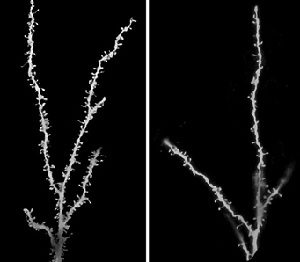
The left shows a brain cell from an autistic brain. It has a higher number of synapses than the neurotypical brain cell on the right.
FAULTY WIRING: Studies suggest that autistic individuals have an excess of synapses (connections between brain cells), but that some do not work well enough to do their job. MRI scans of typical brains often show synchronized activity in the front of the brain with areas towards the back, which suggests that the two lobes communicate well with each other. ASD brain scans, on the other hand, show a “lack of synchrony between frontal and posterior areas.” The Brain Wide Association Analysis (BWAS) identified this type of reduced activity in a region involved with facial expression processing used in social behavior. BWAS also identified reduced connectivity with the ventromedial prefrontal cortex—an area associated with emotion and social communication.
16TH CHROMOSOME: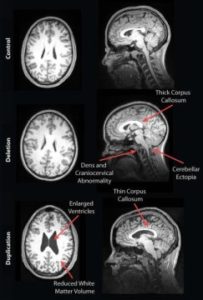 Many people with autism have abnormalities at a specific site on the 16th chromosome (16p11.2). It is believed that deletion or duplication of this site is one of the most common causes of ASD. Researchers at UCSF had deletion carriers, duplication carriers, and neurotypical controls undergo MRI exams and complete cognitive and behavioral tests; brain images reviewed notable differences in brain structures between groups. Deletion carriers showed brain overgrowth in the cerebellum and duplication carriers showed brain undergrowth in ventricles. Deletion carriers indicated in cognitive tests a struggle with social skills and communication.
Many people with autism have abnormalities at a specific site on the 16th chromosome (16p11.2). It is believed that deletion or duplication of this site is one of the most common causes of ASD. Researchers at UCSF had deletion carriers, duplication carriers, and neurotypical controls undergo MRI exams and complete cognitive and behavioral tests; brain images reviewed notable differences in brain structures between groups. Deletion carriers showed brain overgrowth in the cerebellum and duplication carriers showed brain undergrowth in ventricles. Deletion carriers indicated in cognitive tests a struggle with social skills and communication.
 BACK TO BEHAVIOR: Certain characteristics of ASD inherently go against typical dating norms. For example, a neurotypical person may believe a bar or a concert to be a great place for a first date. However, loud and crowded places, flashing lights, and jumbled conversation can trigger sensory overload in ASD individuals, causing issues with EF characteristics mental flexibility and inhibition, brought by hypersensitivity from over and under-connectivity between brain cells.
BACK TO BEHAVIOR: Certain characteristics of ASD inherently go against typical dating norms. For example, a neurotypical person may believe a bar or a concert to be a great place for a first date. However, loud and crowded places, flashing lights, and jumbled conversation can trigger sensory overload in ASD individuals, causing issues with EF characteristics mental flexibility and inhibition, brought by hypersensitivity from over and under-connectivity between brain cells.
Open communication is important in all relationships. To prevent misunderstanding, it is important for people to educate themselves on neurally diverse individuals before making assumptions about intentions. Sometimes to truly see people for who they are, one must understand them from their synapses to their behaviors. 
LINKS:
https://www.rainbowrehab.com/executive-functioning/
http://www.iflscience.com/brain/wiring-autistic-brains-shown-be-highly-individualized/
https://www.sciencedaily.com/releases/2017/08/170808074314.htm
https://www.sciencedaily.com/releases/2014/12/141202144827.htm
Speak Your Mind